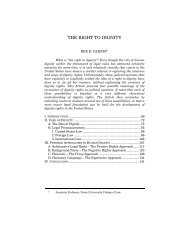A Right to Media? Lorie M. Graham - Columbia Law School
A Right to Media? Lorie M. Graham - Columbia Law School
A Right to Media? Lorie M. Graham - Columbia Law School
You also want an ePaper? Increase the reach of your titles
YUMPU automatically turns print PDFs into web optimized ePapers that Google loves.
2010] A RIGHT TO MEDIA? 485<br />
In 2002, Aboriginal Voices Radio, a national Aboriginal radio<br />
network, was launched with its initial station in Toron<strong>to</strong>. 215<br />
In terms of legislative protection for First Nations<br />
broadcasting, the Canadian government has been involved in<br />
indigenous language broadcasting for several decades. The main<br />
institution charged with supervising telecommunications is the<br />
Canadian Radio-television and Telecommunications Commission<br />
(CRTC). 216 The Communication Moni<strong>to</strong>ring Report issued by the<br />
CRTC in 2008 stated the Commission’s objective with regard <strong>to</strong><br />
diversity is <strong>to</strong> “ensure all broadcasters contribute <strong>to</strong> a system that<br />
accurately reflects the presence in Canada of ethnocultural<br />
minorities, Aboriginal peoples and persons with disabilities.” 217 The<br />
Report states that consistent with subsection 3(1)(d)(iii) of the<br />
Broadcasting Act, the Canadian broadcasting system should “serve<br />
the needs and interests, and reflect the circumstances and<br />
aspirations of Canadian men, women and children . . . the special<br />
place of Aboriginal peoples within that society.” 218<br />
The Commission’s objectives are <strong>to</strong> ensure that broadcasting<br />
presents an “accurate reflection of the presence (i.e., “who we see”<br />
and “who we hear”) of ethnocultural minorities” as well as<br />
“Aboriginal peoples and persons with disabilities; and<br />
the accurate, fair and non-stereotypical portrayal (i.e., “how we see”<br />
and “how we hear”) of such groups.” 219 The Commission seeks <strong>to</strong><br />
215. Id. at 12.<br />
216. The CRTC was established by the Canadian Parliament in 1968 and<br />
is an independent public authority constituted under the Canadian Radiotelevision<br />
and Telecommunications Commission Act. Canadian Radio-television<br />
and Telecommunications Act. R.S.C., ch. C-22, (1985), amended by R.S.C., ch. 38,<br />
§ 80 (1993). The CRTC is vested with the authority <strong>to</strong> regulate and supervise all<br />
aspects of the Canadian broadcasting system, as well as <strong>to</strong> regulate<br />
telecommunications common carriers and service providers that fall under<br />
federal jurisdiction. Broadcasting Act, S.C. 1991, ch. 11, § 5(1) (Can.). The CRTC<br />
derives its telecommunications regula<strong>to</strong>ry powers from the Telecommunications<br />
Act (S.C. 1993, ch. 3, § 9, amended by S.C. 1999, ch .31,, § 196(F) (Can.)), and the<br />
Bell Canada Act (S.C. 1987, ch.19, §§ 6(2)(c), 11(2), 12, amended by S.C. 1993, ch.<br />
38, § 80 (Can.)).<br />
217. Can. Radio-television & Telecomm. Comm’n, Communications<br />
Moni<strong>to</strong>ring Report §2.3 (2008), available at http://www.crtc.gc.ca/eng/publications<br />
/reports/PolicyMoni<strong>to</strong>ring/2008/cmr2008.htm.<br />
218. Id.<br />
219. Id. § 2.3.















